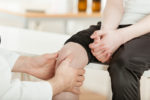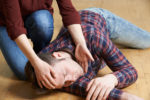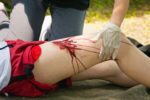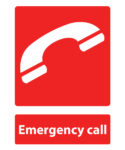Cerebrospinal fluid is a type of body fluid which looks very similar to water. It is a liquid that is clear and colourless. One of its main functions is to protect the central nervous system from damage. It provides mechanical protection and is found surrounding the brain and the spinal cord. The brain produces around […]
Articles Tagged: Trauma
Common Skeletal Injuries
The human body has 206 bones, and all of these are able to break. Any break of a bones, whether that be a tiny fracture, chip or the bone completely shattering, it is called a bone fracture. Here are some of the most common bones to become injured. Skull (Cranium) Injuries to the skull will […]

Joint examination
Joint examination is the basic examination of any joint. No matter what joint you are looking at, the same process should follow. All joints will move in a set parameter, so they will have their normal, natural movement. In your joint examination, you will be looking for any signs of unnatural movement or pain. Identifying […]
Adult fractures
Someone can fracture a bone by falling, being hit, having a joint pulled or twisted, crushing, or a bone is bent. Any break in a bone is called a fracture. It is often that hospital treatment is the only place where fractures can be confirmed – with the use of X-Rays. Someone who has fractured […]

Spinal Recovery Position
The spinal recovery position is a variant of the normal recovery position. This should be used if you suspect the patient has injured their spine. With the normal recovery position, the persons’ spine is liable to be moved about quite a lot. If a person has injured their spine, moving them could cause further damage. […]

Coagulopathy
Coagulopathy is a condition in which the blood’s ability to coagulate – clot – is impaired. This would mean that if someone had a serious bleed, the bodies’ ability to form clots and stop the bleeding would be reduced. This condition can cause prolonged or excessive bleeding, which occurs typically during any sort of medical […]

Trauma from Choking
During an emergency situation, the timely resolution of the most life-threatening cause is paramount and choking is certainly one of those instances. Hence, the damage caused by the use of aggressive and forceful compressions, thrusts, and back blows warrant the collateral damage from these interventions. Any injuries sustained are irrelevant if the person is dead. […]

Calling the Emergency Medical Services
There are lots of cases where you may have to call the Emergency Medical Services. This can include any serious road traffic accidents, serious burns, drowning and major bleeds. Calling the Emergency Medical Services (EMS) is simply done by calling 999 or 112. 999 is the UK wide phone number. 112 is the European number […]

Shock
Shock is defined as a lack of oxygen to the body’s tissues. Many different things can cause this, and there are lots of different types of shock. Types of Shock The first one is hypovolemic shock. This occurs normally during or after a major trauma incident, for example, a car crash, where the patient loses […]
